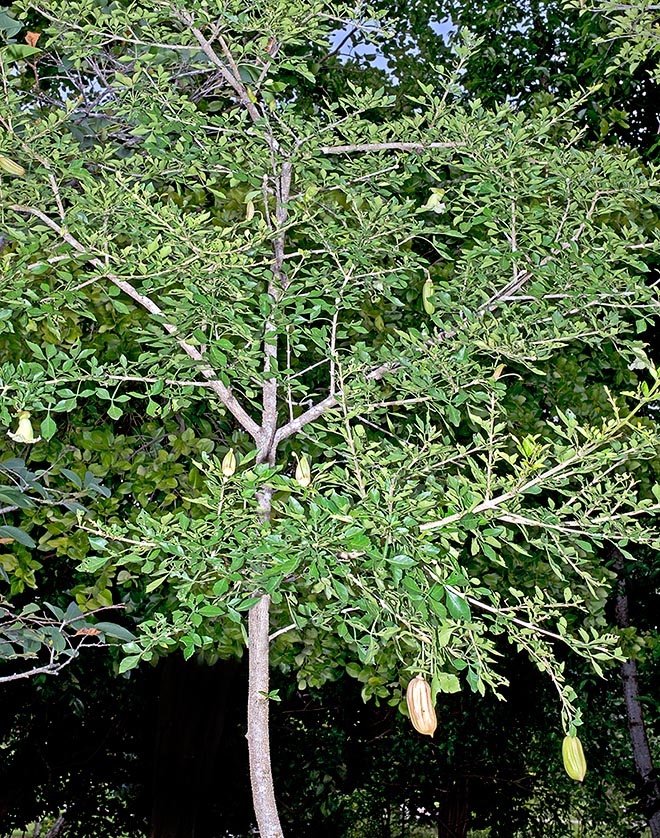Family : Bignoniaceae

Text © Pietro Puccio

English translation by Mario Beltramini

Parmentiera aculeata is a shrub or small evergreen or semideciduous 7-10 m tall very ramified tree © G. Mazza
The genus is honoured to the French agronomist and pharmacist Antoine Augustin Parmentier (1737-1813); the specific name is the Latin adjective “aculeatus, a, um” = equipped with thorns, thorny, with obvious reference.
Common names: candle tree, cat, cow okra, cucumber tree, snake okra (English); bananinha, guajilote (Brazil); cuajilote, palo de velas (Costa Rica); ají de Cabaiguán (Cuba); fruto de cera (Ecuador); camburito (Guatemala); chayote, chucho, cuajilote, guachilote, huajilote, palo de jilote, pepino cat, pepino kat, pepino de árbol, pepino de monte (Mexico); camburito (Venezuela).
The Parmentiera aculeata (Kunth) Seem. (1854) is a shrub or a small tree evergreen or semi-deciduous much ramified, 7-10 m tall, with erect trunk, up to about 30 cm of diameter, with the bark of pale brown colour slightly fissured; the young branches are provided of couples of curved thorns on the nodes.
The leaves, on a 2,5-5,5 cm long winged petiole, are opposite, sub-opposite or fasciculate, usually trifoliate, with elliptic to obovate leaflets with obtuse or pointed apex and entire margin, 2-7 cm long and 1,5-3 cm broad, the terminal being bigger than the lateral ones, of glossy intense green colour. Solitary hermaphroditic flowers or fasciculated directly on the trunk or the main branches (cauliflory), odourless, with tubular calyx laterally open, about 3 cm long, of green colour, campanulate corolla, 5-7 cm long, of greenish white colour at times run by some purple brown line, with 5 curved lobes with wavy margins slightly unequal and 5 stamina, one of which sterile.
The fruit is a fleshy berry, fibrous, greenish yellow, of almost cylindrical shape with longitudinally prominent ribs and pointed apex, slightly curved, 8-18 cm long and of 3-5 cm of diameter, containing numerous roundish flat seeds of about 3 mm of diameter.
It reproduces easily by seed in draining loam maintained humid at the temperature of 24-26 °C, with germination times of 1-5 weeks and first blooming after 3-5 years.

Solitary flowers and edible fruits, often used for animal feeding. All parts of the plant are used in the traditional medicine for various pathologies © Giuseppe Mazza
All parts of the plant are utilized since remote times in the traditional medicine for various pathologies.
Synonyms: Crescentia edulis Desv. (1814); Parmentiera edulis DC. (1838); Crescentia aculeata Kunth (1818); Crescentia musicarpa Zaldivar ex C.Heller (1853); Parmentiera foliolosa Miers (1868); Parmentiera lanceolata Miers (1868); Crescentia edulis Sessé & Moc. (1889).
